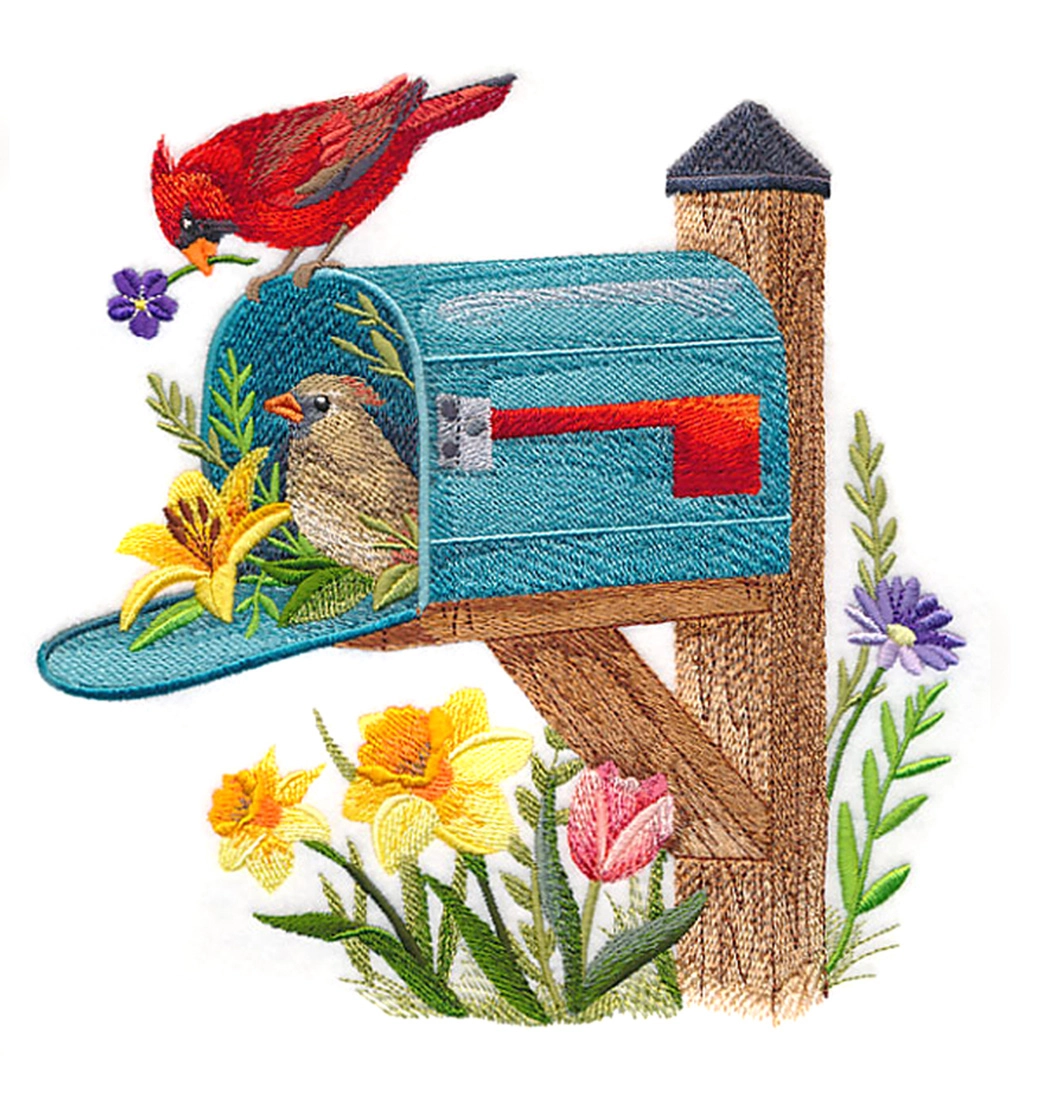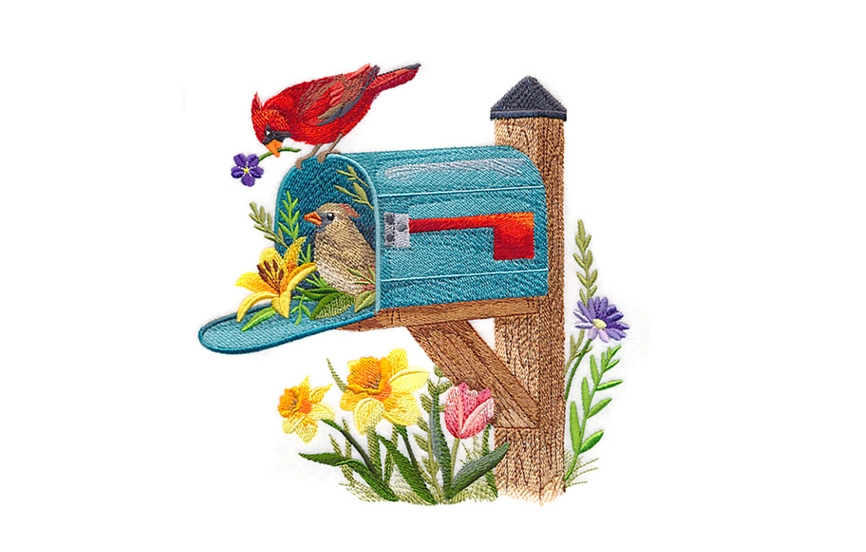Cheer up your home with a delightful spring-themed table runner. Change the designs and fabrics to suit any style or season.
This beautiful table runner was specially created to coordinate with the patchwork placemat, March's installment of the Placemat of the Month series.
Read below for these free project instructions, then click here for instructions on how to create coordinating patchwork placemats.
You love the Placemat of the Month series, so once per quarter, we're creating a bonus coordinating table runner to spark your creativity. The patchwork table runner is the first installment of 2011 and perfectly complements March's patchwork placemat. Get started today!
Other table runner projects in this series include:
January - Snowball Block Placemat
February - Lots of Love Placemat
April - Spring Pinwheel Placemat
May - Sunflower Fiesta Placemat
June - Summertime Trapunto Placemat & Summertime Trapunto Table Runner
July - Crafty Cravings Placemat
August - Puppy Love Placemat
September - Autumn Abundance Placemat & Autumn Abundance Table Runner
October - Sumi-e Embroidered Placemat
November - Give Thanks Pocket Placemat
December - Rudolph's Run Placemat & Rudolph's Run Table Runner
Supplies
Supplies Needed:
- 1 1/2 yards solid-colored quilter's cotton (for embroidered pieces and back)
- 1/4 yard print quilter's cotton (for borders)
- Small pieces of print quilter's cotton (for front panel)
- Batting or extra-loft batting
- Medium-weight or light-weight cutaway stabilizer
- Temporary spray adhesive
- Air-erase pen (or other marking tool)
- Straight edge
- Quilting cutting mat
- Rotary cutter
- Nylon monofilament thread
- Needle and thread for some hand sewing
Designs used:
Vintage Jacobean Flower 5 (Medium)
Vintage Jacobean Flower 8 (Medium)
Blue Flax (Vintage) - (Medium)
Hollyhock (Vintage) - (Medium)
These designs are also available in design packs:
A Vintage Jacobean Floral Design Pack - Large, Medium, Small
A Flowers of the Holy Land (Vintage) Design Pack - Large, Medium, Small
Finished Size:
51 inches inches wide by 12 1/2 inches high

To begin, prepare the fabric for the embroidered pieces. Using an air-erase pen (or other marking tool), draw a 6 1/4 inch wide by 10 1/4 inch high rectangle on the solid-colored quilter's cotton - leave a couple of inches of excess fabric around the shape. Measure and mark the center of each side of the shape by measuring and dividing by two. Draw lines to connect the marks. Where the lines meet is the exact center of the shape.

Create a paper template of the design by printing it at full size using embroidery software. If you don't have embroidery software, you can cut a piece of paper the shape and dimensions of the design to help with placement and centering. If you'd like a recommendation for an embroidery program that can make templates, consider Embird from www.Embird.com.
Poke a hole in the center of the template and align it with the center point on the fabric. Make sure the design fits well within the shape - there should be at least one inch of space between the edges of the design and the edges of the shape.

Spray a piece of medium-weight or light-weight cutaway stabilizer with temporary adhesive and smooth the fabric on top. Hoop the fabric and stabilizer together by aligning the marks on the hoop with the lines on the fabric. Attach the hoop to the machine and load the first design. Move the hoop so that the needle is aligned with the center point on the fabric. Embroider the design.

After the design has finished, trim away the excess stabilizer on the back of the embroidery.
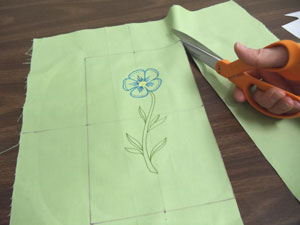
Cut out the shape.

Prepare the remaining embroidered piece by drawing an 8 1/4 inch by 8 1/4 inch square on the solid-colored fabric.
Follow the same process of measuring, hooping, and embroidering as you did for the first embroidered piece.

Cut a 6 1/4 inch wide by 2 1/4 inch high piece of print quilter's cotton and align it with the top edge of the first embroidered piece with right sides facing. Pin in place and sew a 1/4 inch seam along the pinned edge only.

Press the back seam open with an iron. This is the left front panel.
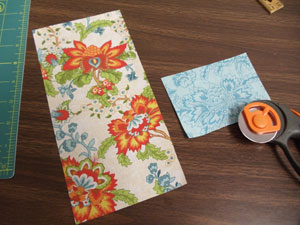
To prepare the the center panel piece, cut a piece of print fabric 4 1/2 inches wide by 9 1/4 inches high and another piece 4 1/2 inches wide by 3 1/4 inches high.

Align the smaller piece with the bottom edge of the larger piece with right sides facing. Pin in place and sew a 1/4 inch seam along the pinned edge, and press the seam.
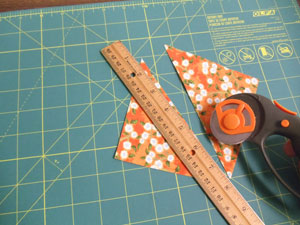
To prepare the right front panel, start by cutting a 4 3/4 inch by 4 3/4 inch square piece of print fabric. Cut the square in half diagonally from one corner to the next.
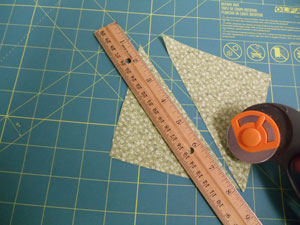
Cut another piece of print fabric 4 3/4 inches by 4 3/4 inches and cut it in half diagonally as you did with the first piece.

Align two of the pieces together with right sides facing and pin in place. Sew a 1/4 inch seam along the long edge and press the seam.

Cut a piece of print fabric 4 1/2 inches wide by 4 1/4 inches high. Align the pieced square along the right edge of the square you just cut, with right sides facing. Pin in place along the right edge and sew a 1/4 inch seam along the pinned edge only. Press the seam.

Next, align the pieced squares along the bottom edge of the remaining embroidered piece with right sides facing. Pin in place and sew a 1/4 inch seam along the pinned edge only. Press the seam.
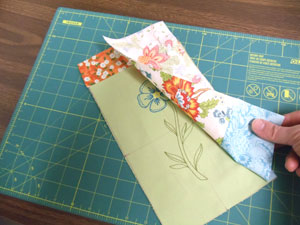
Lay the left embroidered panel flat and align the middle front panel on top with right sides facing. Pin in place along the right edge and sew a 1/4 inch seam along the pinned edge only.

Lay the assembled left and middle panels flat and align the right panel on top of the center panel with right sides facing. Pin in place along the right edge and sew a 1/4 inch seam along the pinned edge only.

Create as many front panels as you'd like depending on how long you want the runner to be -each panel is about 19 inches wide and the end pieces will add about 16 inches to the total width. We prepared two front panels for our runner.

Now we will add a fabric piece in between the panels. Cut a piece of print fabric 1 1/2 inches wide by 12 inches high. Align it with the right edge of the left panel with right sides facing. Pin in place, and sew a 1/4 inch seam along the pinned edge only.

Align the right panel on top of the assembled left panel with right sides facing. Align it with the right edge of the piece you just added. Pin in place and sew a 1/4 inch seam along the pinned edge only.
If you will be using more than two front panels, repeat the last two steps.

Now, we will prepare the fabric for the triangular ends of the table runner. Cut a piece of print fabric 4 1/2 inches wide by 9 1/4 inches high. Then, cut another piece 4 1/4 inches wide by 9 1/4 inches high. Align the second piece (smaller piece) on top of the first piece with right sides facing and pin in place along the right edge. Sew a 1/4 inch seam along the right edge only and press the seam.
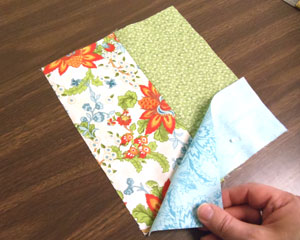
Cut a piece of print fabric 8 1/4 inches wide by 3 inches high and align it with the bottom of the assembled piece with, right sides facing. Pin in place and sew a seam along the bottom pinned edge only. Press the seam.
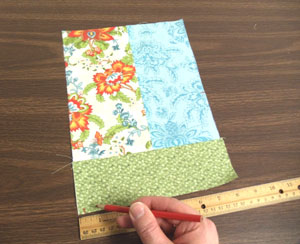
Measure and mark the center of the right edge by measuring and dividing by two. Then, measure and mark in 1/4 inch along the top and bottom edges by starting at the top left and bottom left corners.

Draw lines to connect the corner marks to the center mark on the right edge.

Cut out the shape along the lines you just drew. Then, repeat the piecing and cutting process so you have a total of two end pieces.

Now, align the end pieces with the short ends of the assembled panels with right sides facing. Pin in place and sew a 1/4 inch seam along the pinned edge. Press the seams.

Now we will prepare the fabric for the borders. To start, cut four pieces of print fabric 15 inches long by 1 1/2 inches high. Measure and mark the center of one long side of each of the pieces of fabric by measuring and dividing by two. Then, measure and mark the center of each side of the triangular ends by measuring and dividing by two.
Align the border pieces on top of the triangle ends with right sides facing and center points aligned. Pin in place and sew a 1/4 inch seam along the pinned edges starting and stopping 1/4 inch in from each corner (align the border fabric with right sides facing at each end point so it will not be sewn over).

To miter the borders at the pointed ends, press the back seams open and continue the fold to the ends of each border piece. Align the ends of the border pieces together at the end points and fold the triangular end in half widthwise. Pin in place.

Align the straight edge with the bottom fold of the triangular end piece and draw a line across the border pieces. Sew a seam across the line.

Trim off the excess fabric next to the seam leaving about 1/4 inch of excess.

To prepare the top and bottom borders, measure the length of the table runner from corner to corner along one of the top or bottom edges and add add 4 inches (this is the length of your top and bottom border pieces). Ours measured 36 inches, plus 4 inch equals 40 inches. So, we cut two pieces of print fabric 40 inches long by 1 1/2 inches wide. Measure and mark the center of one of the long edges by measuring and dividing by two. Then, measure and mark the center of the top and bottom edges of the front panels by measuring and dividing by two.
Align the border pieces on top of the front panels with right sides facing, and the center points aligned. Pin in place and sew a 1/4 inch seam along the pinned edges starting and stopping 1/4 inch from each corner (again, align the border with fabric right sides facing at each corner point so it will not be sewn over).
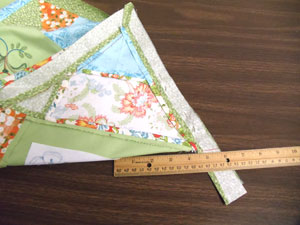
To miter the corners, align the border fabric and seam of the triangular end with the top border fabric and seam of the front panel. Fold the front panel. Then, draw a line out across the border fabric as you did earlier and sew a seam along the line. Trim the fabric and repeat this process for each corner - align each corner with the top and bottom border fabric respectively.
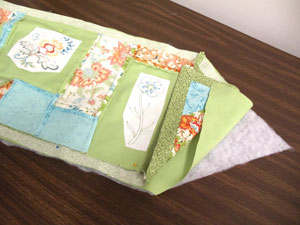
To prepare the fabric for the back of the table runner, lay the assembled front panel on top of the fabric, pin, and cut out the shape. Also, cut a piece of the batting just as you did for the back.
Lay the batting flat and align the back fabric on top with the right side facing up. Align the front panel on top of the back fabric with right sides facing (wrong side of the front panel faces up). Sew a 1/4 inch seam around the outer edges of the table runner leaving about 7 inches open along the bottom for turning.
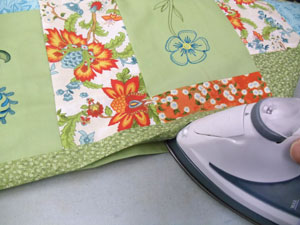
Turn the table runner right side out between the front and back panels (the batting will end up inside the table runner), and press the seams. Also, turn the fabric of the opening in 1/4 inch and press. Hand-sew the opening closed using a needle and thread.
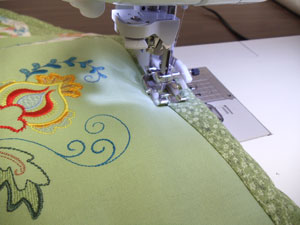
With nylon monofilament in the needle and matching thread in the bobbin (thread that matches the back fabric) quilt through all the layers by stitching along the existing seams of the front panel.

We also quilted around the edges of the embroidered pieces. To do this, first measure and mark 3/4 inch in around the edges of each piece. Draw lines connecting the marks and then stitch along the lines through all the layers (we used a decorative stitch).
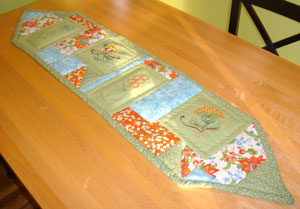
Your table runner is now complete! Click here to learn how to stitch coordinating patchwork placemats!

